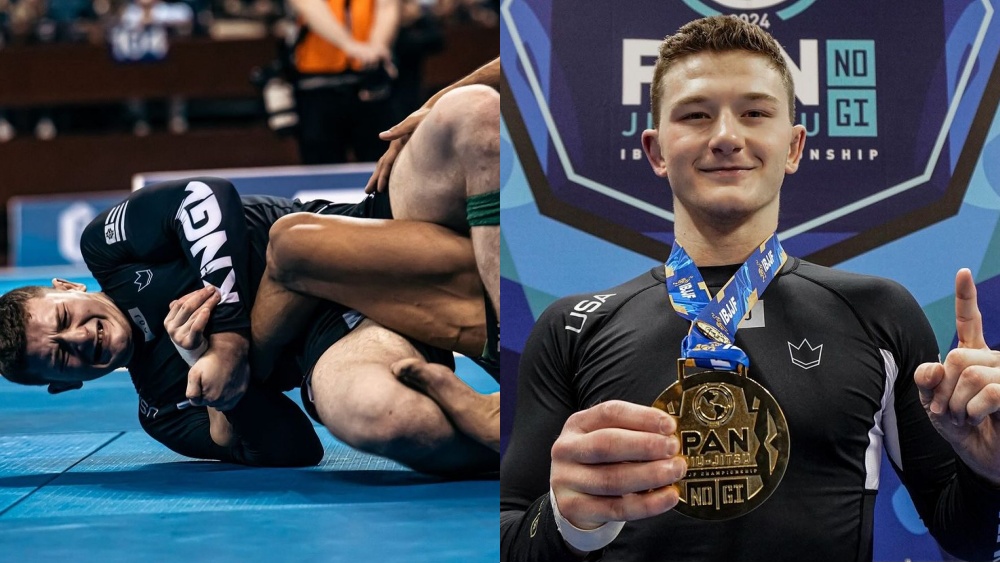Leg locks have been dominating the grappling scene for the past few years. To become competitive in modern BJJ, grapplers need to familiarize themselves with the different leg lock positions to build their offensive and defensive arsenals. In BJJ and all martial arts, an uncharted area of your game can become your weakness, especially when challenged by fierce competition. Worry not, as today, we will talk about likely the most powerful leglock position in grappling: the saddle.
What Is The Saddle In BJJ?
The saddle is a position of many names – some grapplers refer to it as the inside sankaku, honey hole, 411, and cross ashi. Many consider it the most potent leglock position in grappling. The saddle position controls an opponent’s leg by locking both your legs (most common is pinching your legs similar to a triangle) above their knee, with your hips rotated slightly at a different angle relative to the opponent’s knee, like in the knee bar position.
This position is a powerful controlling position with different advantages. It allows you to control the opponent’s ability to hand fight, move around, escape, and counterattack while enabling you to control their other leg to create a more stable position. Most of all, it can be used as an entry for the inside heel hook, the Aoki lock, and a transition point to other leg entanglements.
Entry From The Butterfly Guard
There are different ways to enter the saddle position. One of the common ones is from the butterfly guard. Starting from the seated butterfly guard, you want your leg to elevate the opponent to point toward the ceiling. The other leg should be pointing outwards so that you can extend it below the opponent’s center when you start to sit through for the elevation.
Assuming you’re using your left leg to elevate the opponent, use your left hand to grab behind the opponent to their far hip. From here, dive your head and right arm for an underhook on the opponent’s far leg. Turn your body as you do the motion to be perpendicular to the opponent. Continue turning your body and lift the opponent above you while keeping the underhook.
From this position, your legs can assist by lifting the opponent and holding them up effortlessly regardless of their sprawl because your left knee and leg are perpendicular to the floor. Use your left hand to post on their armpit to keep distance. While keeping the butterfly hook with your left leg, use your right leg and bring it straight up behind the opponent’s leg to force the opponent to the mat as you land in the saddle position.
Entry From The Dogfight Position
This entry to the saddle from the dogfight position will require you to have a half-butterfly hook. The first entry is if you are squared with the opponent and have an under hook with your right hand and a right leg butterfly hook applied to the opponent. Use your left hand to post on the mat and your left leg to step to the left side.
From this position, tuck yourself under the opponent and roll through below them. Use your left hand to grab behind the opponent’s knee that you are trapping. As you roll and land on the mat, you are now in the saddle position. Often, the opponent will not simply give the underhook and will fight for it. The second option comes in with the overhook variation. While still having your right leg butterfly hook, and now with a right-hand overhook applied on the opponent with them having an underhook up to your far lat, rather than shooting yourself and left hand underneath the opponent, use your left hand to grab outside the opponent’s trapped leg and roll.
Before rolling, you can use your left hand to grab your right shin from the outside to help you control your roll if the opponent starts sprawling. Upon landing in the saddle position, the opponent may grab your head with both hands coming from the underhook; you can let go of the saddle and shoot out your legs to land on side control.
Entry From Reverse De La Riva
Assuming the opponent tries to go for a knee cut, and you have a reverse De La Riva with your right leg, you want your hip underneath the opponent’s hooked knee. Use your right hand to grab high above the opponent’s calf. While holding the grip and the RDLR hook, push the opponent’s near hip with your left leg and invert on your right shoulder. Pull back your right RDLR hook and use your left hand to grab behind the opponent’s knee.
As you do, invert and shoot your right leg behind the opponent’s knee and lock it with your left leg for a triangle above the opponent’s knee. Another advantage of having your right hand gripping behind the opponent’s calf is that it gives you the ability to expose the opponent’s heel and go directly for an inside heel hook as soon as the opponent falls to the mat.
Now that you’re inverted and keeping the control in place, place your left hand and grip on the back of the opponent’s trapped knee for support so they can’t pull it out. Finish the sweep by bumping your hips forward to land on the saddle position. As the opponent lands on the mat, their heel will be exposed. You can catch the heel hook by having your right elbow near the trapped leg’s toe, circling back, hooking behind the heel, and locking your hands to finish.
Conclusion
When in the saddle, always remember to have good control over the opponent’s leg to make the most of the position. Good control comes from key details such as pinning the opponent’s hips, controlling their far leg, and pinching your knees together. Begin your leg lock journey by practicing the saddle position and see how it revolutionizes your game.
You may also like:
















